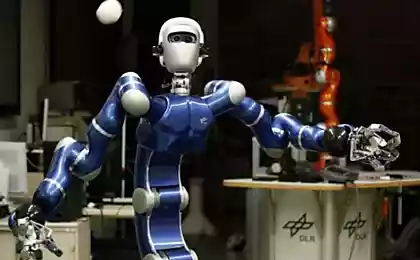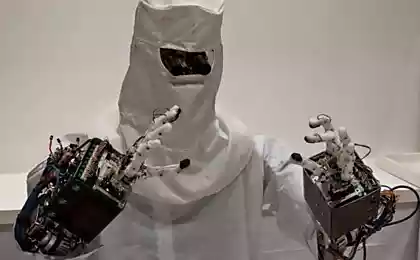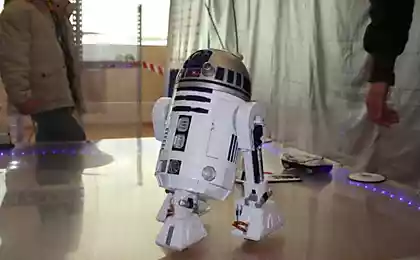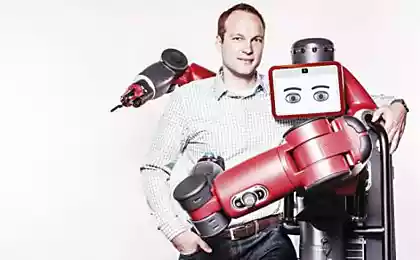532
What makes realistic robots so scary?

Ever since Karel Capek coined the term robot in his 1920 play, the robots are firmly nestled in science fiction. In our days they have become a scientific and technical fact, one cannot refuse. Robots are used for cleaning, construction, cars, deactivate bombs, assist in surgery and the disabled, and in many other ways. They are more common than many of us might think, and in the future their population will grow even more.
If a robot is a machine that can perform tasks ordinarily performed by people. Some of them are managed by operators, some are offline (yet allow the power supply). In form they vary from individual robotic manipulators to a full humanoid bodies. One of the main goals of some of robotics is robot creation, as similar to the human, at least in part, to facilitate natural interaction between robots and humans. A robot that is more like a person, and is perceived much better.
Today, there are already quite a lot of androids that are used in scientific research, like Repliee Q2, developed by Hiroshi Ishiguro of Osaka University. Repliee Q2 was designed as a TV presenter a female, and at first glance it could be mistaken for human. She can't walk and has a complex artificial intelligence, so its functionality is limited. Ishiguro has also created a remotely operated Android copy of himself and named it Geminoid HI-1, to read lectures remotely. David Hanson created a model of Android, like Philip K. dick in "do androids Dream elektroauto?", which can recognize faces and to keep the conversation going. Although none of the androids does not yet possess full autonomy, almost a full copy of a person will appear as a result of these attempts. However, for some reason, when we are faced with robots that are too like us, we find them repulsive and creepy.
Why realistic robots scare us? Perhaps we fear something that has the abilities of a man but does not possess consciousness? Or you're afraid of losing their own uniqueness? At the moment the answer seems more carnal than philosophical. Is it the effect of "sinister valley."
"Sinister valley"

We all tend to anthropomorphize objects and animals. That is, to project human qualities like intelligence and emotions in nonhuman things, especially if they still possess some human traits. From this we can conclude that you'd rather talk with a humanoid Android, but not metal mechanoids. Apparently, we feel comfortable with robots, the quality of which up to a certain point similar to human. After this point everything is changing dramatically. This effect is called "uncanny valley".
The term "sinister valley" was invented by Masahiro Mori in 1970. To illustrate his idea, Mori created a graph where on the y-axis was a factor of recognition, and the x — axis shows the degree of similarity on the person, and portrayed our sense of recognition, or the ability to identify, for example, different robotic forms or representations of a person. Industrial robots are somewhere near the point of origin, they don't look recognizable or similar to humans. But after the peak there is a sudden failure in "the valley" (where are the corpses, zombies and prosthetic), which develops into a second peak depicting a living person. From the point of view of Mori, our comfort level increases, while the quality of the robot to acquire human form, but not reach the point of identification in which a person suddenly ceases to recognize the robot and frightened. The role played by physical appearance, and movement, as the inhuman traffic immediately send us to "the uncanny valley" (and some movies like "silent hill" on this and based).

Studies have confirmed the idea of the Mori, although a bit modified. Researchers Carl Macdorman, Robert green, Chi-Chang Ho and Clinton Koch, Indiana University used a still image with the features and textures of the skin, modified in various ways to know the reaction of respondents. Scientists have found that the level of eeriness was increased when individuals deviated from normal human proportions, and skin texture was realistic, but back when the realism of the skin decreased. These results indicated that the culprit may be a mismatch between the proportions and realistic details.
In the study, Ayse Pinar saygin, Thierry Chaminade, Hiroshi Ishiguro, Jon Driver and Chris Firth used a moving robot (Repliee Q2), which showed that the effect of "sinister valley" may be caused by a discrepancy between our expectations and reality in terms of appearance and movements of an Android. The researchers did functional magnetic resonance imaging participants while they watched a series of videos with Repliee Q2 (the same Android, but without "skin") and a live person, who performed the same actions. The brains of the participants reacted very similar to human and mechanized robot. But if you are monitoring similar to the person the Android was working absolutely other region of the brain responsible for the definition and interpretation of movements. It was concluded that perhaps the effect of "sinister valley" is caused by something that looks human, but is moving improperly. Robots move as they should move the robots, humans as people, and neither the first nor the second does not daunt us, unless there could be confusion.
One of the possible evolutionary reasons for our aversion to the discrepancy between appearance and movements of an Android can be that any abnormality in a person can indicate a disease, our brain rejects it firmly, to prevent the spread. A kind of otherness in the other person can also run our dislike of people we do not consider acceptable partners for mating. Whatever was the basis of the causes of the uncanny valley, the robotics looking for ways to get their creations out.
Do we need a bridge to "the uncanny valley"?
Although some robotics want to make androids so similar to humans in appearance and movement that they can go through the "uncanny valley", many decide this question, not making a humanoid, but very expressive robots. For example, Leonardo is cute and fluffy robot is made in cooperation MIT and Stan Winston Studios. It can show different facial expressions and learn from people of different skills. Researchers like Jizera knight believe that the social capabilities of robots can also be the key to escape from uncanny valley.
There is also an opinion that robots should be social, to look and act accordingly, but only that people were comfortable with them; robots should not be human. The idea is to give robots enough functions anthropomorphizes them, for example, the ability to understand and maintain a conversation, to recognize emocionalnoe the human condition and respond appropriately and Express their own emotions and personality. The robots should have its own form, which starts from the purpose of the robot, but does not match our expectations of how they should look. Sam Mori in 1970, stated that designers should aim for the first peak on the graph, not the second, not to get in the zone of the uncanny valley. Perhaps this approach would help robots to remain inconspicuous in our life, but very useful.
Others continue to strive for full human realism, as Ishiguro, who believes that androids can overcome the "uncanny valley", increasing human-like appearance and movement. In addition to the realistic textures of skin and hair, his Repliee Q2 and Geminoid HI-1 was continuously performed micromotion, blinked and moved your body like breathing, to look more natural.
Culture can also play a role. In Japan, artificial forms are more common and acceptable than in Europe, for example. In Japan there is even a faux pop star (one animated and the other is generated by the computer). Perhaps the "sinister valley" may simply fade away after the spread of the game. Maybe we just get used to them.
This phenomenon occurs not only with robots. It occurs with other forms of realistic renderings of the human form like animation. There were many reports that people have found animated human characters in the films "final fantasy" and "Polar Express" creepy or repulsive. Although both films were proud of the latest achievements in the field of computer graphics.
We can try everything from lowering realism to create a complete human facial expressions, in further experiments with our brothers smaller robots. We'll have to get used to or, or to overcome the "uncanny valley", because robots and computer graphics will remain with us for a long time.

Source: hi-news.ru























